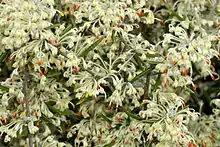Grevillea florida
Grevillea florida is a species of flowering plant in the family Proteaceae and is endemic to the south-west of Western Australia. It is a erect, low shrub with linear to narrowly elliptic leaves, and clusters of hairy, white to creamy yellow flowers with a yellow- or orange-tipped style that ages to red.
| Grevillea florida | |
|---|---|
 | |
| Scientific classification | |
| Kingdom: | Plantae |
| Clade: | Tracheophytes |
| Clade: | Angiosperms |
| Clade: | Eudicots |
| Order: | Proteales |
| Family: | Proteaceae |
| Genus: | Grevillea |
| Species: | G. florida |
| Binomial name | |
| Grevillea florida | |
| Synonyms[1] | |
|
Grevillea uncinulata subsp. florida McGill. | |
Description
Grevillea florida is an erect shrub that typically grows to a height of up to 1 m (3 ft 3 in). Its leaves are linear to narrowly elliptic, 5–30 mm (0.20–1.18 in) long and 1–3 mm (0.039–0.118 in) wide with the edges turned down or rolled under. The flowers are arranged in small groups, and are covered with white to creamy yellow hairs, the end of the style bright yellow or orange but turning red as the flowers age. The pistil is 7–10 mm (0.28–0.39 in) long. Flowering occurs from August to December and the fruit is an oblong or oval follicle about 13 mm (0.51 in) long.[2][3]
Taxonomy
This grevillea was first formally described in 1986 by Donald McGillivray who gave it the name Grevillea uncinulata subsp. florida in his book, New Names in Grevillea Proteaceae.[4] In 2000, Robert Owen Makinson raised the subspecies to Grevillea florida in the Flora of Australia.[5] The specific epithet (florida) means "flowery".[6]
Distribution and habitat
Grevillea florida grows in heath, shrubland or shrubby woodland between Perth, Wannamal, New Norcia, Badgingarra and Yoting in the Geraldton Sandplains, Jarrah Forest and Swan Coastal Plain biogeographic regions of south-western Western Australia.[2][3]
Conservation status
Grevillea florida is listed as "Priority Three" by the Government of Western Australia Department of Biodiversity, Conservation and Attractions,[3] meaning that it is poorly known and known from only a few locations but is not under imminent threat.[7]
See also
References
- "Grevillea florida". Australian Plant Census. Retrieved 23 April 2022.
- "Grevillea florida". Australian Biological Resources Study, Department of Agriculture, Water and the Environment: Canberra. Retrieved 23 April 2022.
- "Grevillea florida". FloraBase. Western Australian Government Department of Biodiversity, Conservation and Attractions.
- "Grevillea uncinulata subsp. florida". APNI. Retrieved 23 April 2022.
- "Grevillea florida". APNI. Retrieved 23 April 2022.
- Sharr, Francis Aubi; George, Alex (2019). Western Australian Plant Names and Their Meanings (3rd ed.). Kardinya, WA: Four Gables Press. p. 200. ISBN 9780958034180.
- "Conservation codes for Western Australian Flora and Fauna" (PDF). Government of Western Australia Department of Parks and Wildlife. Retrieved 23 April 2022.
